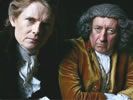Eye For Film >> Movies >> Crooked House (2008) Film Review
Anyone who’s watched more than 30 seconds of any League Of Gentlemen episode will be aware that co-creator Mark Gatiss’ imagination inclines somewhat towards the sinister.
He went on to write some of the scarier episodes of Dr Who and has often spoken in interviews of his love of classic ghost stories, both on the page and in the classic era of TV drama in the mid to late-Seventies.

So it was no great surprise when the BBC announced that one of the shiny sixpences in the plum pudding of its 2008 Christmas schedule was to be a portmanteau production of three different but interconnected spine-chillers – a staple of the schedules in the aforementioned classic era, but also in the golden age of British cinema; I can’t believe that Ealing’s superbly creepy 1945 compendium Dead Of Night wasn’t a subconscious influence at least.
It was aired on BBC4, over three nights, to critical acclaim and good ratings and now gets the full DVD release treatment, with a pretty decent bag of extras. So, without the comforting Yuletide haze of goodwill and sherry, how does it hold up?
Pretty well, in general. Gatiss is obviously a born storyteller, with a knack for boiling a tale down to its essentials, but throwing in enough red herrings and incidental details to keep the viewer pleasantly puzzled. And he knows what scares people – particularly the idea that a house itself might acquire and retain an essence of evil throughout the centuries, generating horror and tragedy for all its inhabitants.
The story begins with Ben (Lee Ingleby), a young schoolteacher, discovers a curious, ornate door knocker lying on the ground when he moves into a new estate. He visits the local museum to discover more, and the curator (Gatiss himself) tells him of its sinister provenance; it was originally part of Geap Manor, owned by a wealthy Elizabethan nobleman who was rumoured to consort with alchemists and black magicians.
After his death the house acquires a cursed reputation, but this doesn’t prevent Bloxham (Philip Jackson), an 18th century entrepreneur grown rich at the expense of his erstwhile partners, from doing it up – until he hears some strange sounds behind the wainscoting... later, a couple of Twenties bright young things are visited by a literal ghost from the past – with whom their grandmother, Lady Constance (Jean Marsh), shares a terrible secret...
Ben is frightened but fascinated by these tales, and decides to install the knocker on his front door. Scary Films Golden Rule Number One duly ignored, he finds that the main character in the final tale is himself...
It all proceeds at a good lick, and director Thomas (who worked with Gatiss on his Captain Scott drama, The Worst Journey In The World) conjures up lashings of atmosphere and a pretty good sense of period detail on an obviously limited budget. Gatiss mixes together a host of influences from classic spine-chillers, notably the M R James ‘sting in the tale’ genre and Shirley Jackson’s ‘old dark house’ classic The Haunting (filmed brilliantly by Robert Wise in 1963 and appallingly by Jan De Bont in 1999), as well as a few distinctive personal touches (the north-east setting, and the gay character in the Twenties segment, commenting with a detached irony on the decadence around him and nourishing a never-to-be-requited crush on the leading man).
It never quite manages to cut to the quick in the manner of the truly classic horror movies, perhaps because of the constraints of a TV-based commission. I’m no fan of gore and excess for its own sake, but a willingness and a budget to go deeper and darker might have yielded true gold. And the ‘surprise’ casting of Derren Brown comes across as a bit of a gimmick.
But all in all its a solid, classy entertainment; the final reveal is a cracker and there are plenty of pleasures on the way (notably Julian Rhind-Tutt’s monologue on being trapped unwittingly inside the house, all the more terrifying for being so restrained). As Christmas approaches and the cinema wheels out its usual parade of zombies, slashers and ‘troubled’ children, you could do worse than turn the lights off and the heating on, curl up with a glass of red or a good single malt and transport yourself back to an era when TV used to produce this sort of class act as a matter of course.
Reviewed on: 18 Nov 2009



















